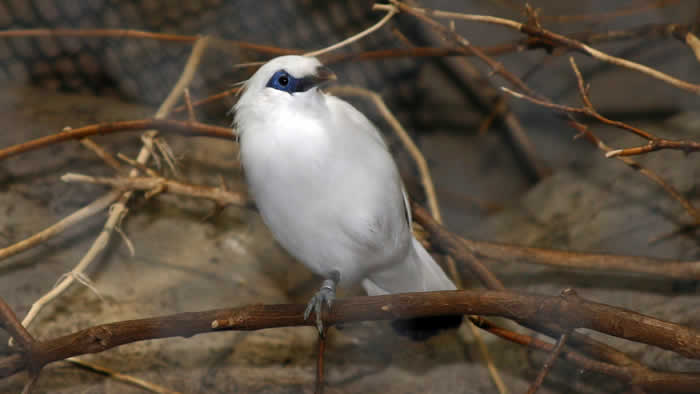Baer’s pochard are one of the most critically endangered ducks in the world. There are estimated to be less than 300 individuals surviving in the wild. The Minnesota Zoo is taking a central role in working to protect this species.
What They Eat
Baer’s pochard eat aquatic plants, mollusks, frogs, small fish and aquatic insects. They will also feed in rice fields. In zoos, they are fed a high-protein waterfowl pellet, small fish and bugs.
Where They Live
These diving ducks are found in lakes, rivers, streams and wetlands. Historically, Baer’s pochard had a widespread range in eastern Asia. Today, they are found mostly in China, but only in small numbers. They are found as single birds in Russia and Myanmar.
What They Do
Baer’s pochard pair with mates in the winter. In the spring, they nest along shorelines with dense cover. A nest contains 6-10 pale-brown eggs. While females sit on the nest, males usually gather in molting grounds.
How They’re Doing
Classified as critically endangered, Baer’s pochard numbers are quickly falling. Scientists are urging a conservation response to bring this species back from the brink of extinction. The main threats are not well understood, but the loss of habitat in breeding and wintering sites is of critical concern, as well as hunting, egg collection, and disturbance for rice agriculture.
Eastern Asia
Habitat
Lakes, rivers, streams and wetlands
Conservation Status
Animal Facts
Length: 16.1-18.5 inches
Weight: males 2.1 pounds, females 1.5 pounds
Wingspan: 27.6 – 31.1 inches
Lifespan: 10-12 years in human care
Taxonomic Category
Bird
Where at the Zoo
Sidebar Content
- Baer’s pochard is named after Dr. Karl Ernst von Baer, a Prussian naturalist.
- These ducks are also known by the name Siberian White-eye pochard or green-headed pochard.
- Baer’s pochard tends to be a quiet, non-vocal species, except during courtship.
- Males and females have blackish green heads and necks. Males are larger and brighter in color than females. The green on a male looks metallic in daylight.
- Male’s eyes are white colored with black pupils, but during times of excitement, their black pupils may become so contracted that they seem to disappear. Females have dark eyes.
- These birds tend to be found in pairs or small groups, but they do mix with other diving duck species at their wintering grounds.
- The breeding range of Baer’s Pochard occurs predominantly in China, with small numbers breeding in Russia. More surveys are needed to learn what areas they could be utilizing for conservation protection.
- The wild population is thought to be fewer than 300 individuals.
The Baer’s pochard is a critically endangered duck, with fewer than 300 individuals thought to be surviving in the wild. It was once relatively common and widespread in Asia, migrating from breeding grounds in northeast China and parts of Russia, to wintering grounds stretching across southern Asia from eastern India to Vietnam and southern China. However, this species has undergone a catastrophic decline in recent years. It was first listed as “threatened” in 1988, uplisted to “vulnerable” in 1994, “endangered” in 2008, and “critically endangered” in 2012. Currently, Baer’s pochard is found in the tens in winter grounds, but only single numbers in breeding areas. Although awareness and an increase in searching for the species has taken place over the past few years, there is still much unknown about their greatest threats and where these birds can be found during the breeding season.
The Convention on the Conservation of Migratory Species of Wild Animals (CMS) and East Asian – Australasian Flyway Partnership (EAAFP) prepared an International Single Species Action Plan (ISSAP) for the Conservation of the Baer’s pochard in 2015. One of the proposed pieces of the plan includes a global management strategy for the captive population of Baer’s pochard. The Minnesota Zoo is taking a central role in this conservation response.
Things the Zoo’s Done/Doing
In December 2014, the Association of Zoos and Aquariums (AZA) created a carefully-managed, conservation-focused breeding program in North American zoos, aquariums and coorperative breeding facilities, to monitor this species. The Baer’s pochard program is managed by staff at the Minnesota Zoo. The current population comes from three imports to two facilities between 2005-2010: Sylvan Heights Bird Park in Scotland Neck, NC, and Pinola Conservancy in Shreveport, LA, totalling 12 founding individuals. Livingston Ripley Waterfowl Conservancy in Litchfield, CT participated in breeding Baer’s pochard as early as 2010, and birds sent to Central Park Zoo in 2010 were the first individuals to have offspring hatched in an AZA facility.
In 2019, the Minnesota Zoo championed a research project to sample the DNA from the North American population of Baer’s pochard in an effort to understand the genetic relationships between individual birds. The results of this study will be incorporated into a breeding and transfer plan in 2020 for North American institutions with this species. The goal is to maximize long-term genetic health of the captive population. This project was collaboratively conducted with funds contributed by Pinola Conservancy, San Diego Zoo, Buttonwood Park Zoo, Akron Zoo and the Minnesota Zoo, along with 22 facilities that submitted DNA samples for the project.
In 2018, the Minnesota Zoo donated funds for a project entitled “Monitoring the status of Baer’s Pochard in Myanmar: wintering numbers and distribution in Myanmar.” This project was conducted by the Baer’s Pochard Task Force, a strategic partnership of the East Asian-Australasian Flyway Partnership (EAAFP). Lead collaborators within the Task Force as related to this project include Dr. Thiridawei Aung of Biodiversity and Nature Conservation Association (BANCA: implementing partner in Myanmar), Mr. Richard Hearn of Wildfowl and Wetlands Trust (WWT), and Dr. Jonathan Slaght of the Wildlife Conservation Society (WCS). The goal of this project is to support global efforts to conserve Baer’s pochard by monitoring known wintering sites in Myanmar, and identifying other important wintering grounds in Myanmar where conservation measures can be implemented.














